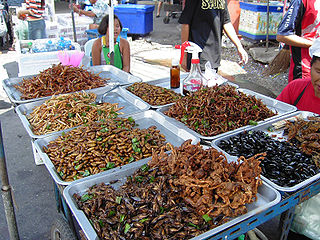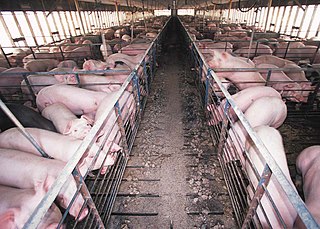
Overgrazing occurs when plants are exposed to intensive grazing for extended periods of time, or without sufficient recovery periods. It can be caused by either livestock in poorly managed agricultural applications, game reserves, or nature reserves. It can also be caused by immobile, travel restricted populations of native or non-native wild animals. However, "overgrazing" is a controversial concept, based on equilibrium system theory.

Millets (/ˈmɪlɪts/) are a group of highly variable small-seeded grasses, widely grown around the world as cereal crops or grains for fodder and human food.

A farm is an area of land that is devoted primarily to agricultural processes with the primary objective of producing food and other crops; it is the basic facility in food production. The name is used for specialised units such as arable farms, vegetable farms, fruit farms, dairy, pig and poultry farms, and land used for the production of natural fibres, biofuel and other commodities. It includes ranches, feedlots, orchards, plantations and estates, smallholdings and hobby farms, and includes the farmhouse and agricultural buildings as well as the land. In modern times the term has been extended so as to include such industrial operations as wind farms and fish farms, both of which can operate on land or sea.

Intensive farming involves various types of agriculture with higher levels of input and output per cubic unit of agricultural land area. It is characterized by a low fallow ratio, higher use of inputs such as capital and labour, and higher crop yields per cubic unit land area. This contrasts with traditional agriculture, in which the inputs per unit land are lower. The term "intensive" involves various meanings, some of which refer to organic farming methods, and others that refer to nonorganic and industrial methods. Intensive animal farming involves either large numbers of animals raised on limited land, usually concentrated animal feeding operations (CAFOs), often referred to as factory farms, or managed intensive rotational grazing (MIRG), which has both organic and non-organic types. Both increase the yields of food and fiber per acre as compared to traditional animal husbandry. In CAFO, feed is brought to the seldom-moved animals, while in MIRG the animals are repeatedly moved to fresh forage.

Animal husbandry is the branch of agriculture concerned with animals that are raised for meat, fibre, milk, eggs, or other products. It includes day-to-day care, selective breeding and the raising of livestock.
In agriculture, managed intensive rotational grazing (MIRG), also known as simply as managed grazing or cell grazing, mob grazing and holistic managed planned grazing, describes a variety of closely related systems of forage use in which ruminant and non-ruminant herds and/or flocks are regularly and systematically moved to fresh rested areas with the intent to maximize the quality and quantity of forage growth.

Trifolium repens, the white clover, is a herbaceous perennial plant in the bean family Fabaceae. It is native to Europe, including the British Isles, and central Asia and is one of the most widely cultivated types of clover. It has been widely introduced worldwide as a forage crop, and is now also common in most grassy areas of North America and New Zealand. The species includes varieties often classed as small, intermediate and large, according to height, which reflects petiole length. The term “white clover” is applied to the species in general, “Dutch clover” is often applied to intermediate varieties, and “ladino clover” is applied to large varieties.

Fodder, a type of animal feed, is any agricultural foodstuff used specifically to feed domesticated livestock, such as cattle, rabbits, sheep, horses, chickens and pigs. "Fodder" refers particularly to food given to the animals, rather than that which they forage for themselves. Fodder is also called provender and includes hay, straw, silage, compressed and pelleted feeds, oils and mixed rations, and sprouted grains and legumes. Most animal feed is from plants, but some manufacturers add ingredients to processed feeds that are of animal origin.

Grazing is a method of feeding in which a herbivore feeds on plants such as grasses, or other multicellular organisms such as algae. In agriculture, grazing is one method used whereby domestic livestock are used to convert grass and other forage into meat, milk and other products.

Different cattle feeding production systems have separate advantages and disadvantages. Most cattle in the US have a diet that is composed of at least some forage. In fact, most beef cattle are raised on pasture from birth in the spring until autumn. Then for pasture-fed animals, grass is the forage that composes all or at least the great majority of their diet. Cattle fattened in feedlots are fed small amounts of hay supplemented with grain, soy and other ingredients in order to increase the energy density of the diet. The debate is whether cattle should be raised on diets primarily composed of pasture (grass) or a concentrated diet of grain, soy, corn and other supplements. The issue is often complicated by the political interests and confusion between labels such as "free range", "organic", or "natural". Cattle raised on a primarily forage diet are termed grass-fed or pasture-raised; for example meat or milk may be called grass-fed beef or pasture-raised dairy. However, the term "pasture-raised" can lead to confusion with the term "free range", which does not describe exactly what the animals eat.

Baby corn is a cereal grain taken from corn (maize) harvested early while the stalks are still small and immature. It typically is eaten whole – cob included – in contrast to mature corn, whose cob is too tough for human consumption. It is eaten both raw and cooked. Baby corn is common in stir fry dishes.

Entomophagy describes the practice of eating insects by humans.

Environmental vegetarianism is the practice of vegetarianism or eating a plant-based diet, based on the indications that animal-based industries are environmentally destructive or unsustainable. The primary environmental concerns with animal products are pollution—including greenhouse gas emissions (GHG)—deforestation, and the use of resources such as fossil fuels, water, and land.

Cottonseed is the seed of the cotton plant.
In animal husbandry, feed conversion ratio (FCR) or feed conversion rate is a ratio or rate measuring of the efficiency with which the bodies of livestock convert animal feed into the desired output. For dairy cows, for example, the output is milk, whereas in animals raised for meat the output is the flesh, that is, the body mass gained by the animal, represented either in the final mass of the animal or the mass of the dressed output. FCR is the mass of the input divided by the output. In some sectors, feed efficiency, which is the output divided by the input, is used. These concepts are also closely related to efficiency of conversion of ingested foods (ECI).

Soybean meal is used in food and animal feeds, principally as a protein supplement, but also as a source of metabolizable energy. Typically 1 bushel of soybeans yields 48 lbs. (21.8 kg) of soybean meal. Some, but not all, soybean meal is produced from the residue left after oil extraction. Removal of the oil, which is used mostly in food, but also for industrial oils, soaps and biodiesel, involves crushing and either pressing or solvent extraction. Some, but not all, soybean meal contains ground soybean hulls. Soybean meal is heat-treated during production, to denature the trypsin inhibitors of soybeans, which would otherwise interfere with protein digestion.

Livestock's Long Shadow: Environmental Issues and Options is a United Nations report, released by the Food and Agriculture Organization of the United Nations (FAO) on 29 November 2006, that "aims to assess the full impact of the livestock sector on environmental problems, along with potential technical and policy approaches to mitigation".
The environmental impact of meat production varies because of the wide variety of agricultural practices employed around the world. All agricultural practices have been found to have a variety of effects on the environment. Some of the environmental effects that have been associated with meat production are pollution through fossil fuel usage, animal methane, effluent waste, and water and land consumption. Meat is obtained through a variety of methods, including organic farming, free range farming, intensive livestock production, subsistence agriculture, hunting, and fishing.

Agricultural engineering is the engineering discipline that studies agricultural production and processing. Agricultural engineering combines the disciplines of mechanical, civil, electrical and chemical engineering principles with a knowledge of agricultural principles according to technological principles. A key goal of this discipline is to improve the efficacy and sustainability of agricultural practices. One of the leading organizations in this industry is the American Society of Agricultural and Biological Engineers.
The concept of an animal unit (AU) has traditionally been used in North America to facilitate planning, analysis and administration of forage use by grazing livestock, but the term has also had other applications. The term has been variously defined by regulation in different jurisdictions, and by livestock management specialists, rangeland resource managers and others. Consequently, when using or interpreting the term, care is needed to ensure that a definition appropriate for the purpose is being used. Most definitions are based on the concept that a 1000-pound (454 kg) cow, with or without an unweaned calf, is one animal unit, with such a cow being assumed to consume 26 pounds of forage dry matter per day.















